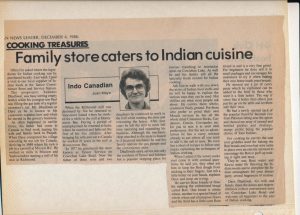“Tansor Convenience Store and Service Station:”
Operating an Indian Grocery Store in Honeymoon Bay during 1970-1980s.
by Trishleen Mahant
Post-1947, South Asian immigration to Canada grew rapidly, as the government made changes to the Immigration Act, which made it easier for many to immigrate to Canada [1]. Upon their arrival, many Indian immigrants settled in British Columbia and usually found work at the sawmills, mainly located in rural parts of Vancouver Island or the lower mainland. The work at
the sawmills was very tiring and low wage, but the workers were provided meals prepared by cooks. However, there was a lack of Indian and South Asian foods at the mill. Moreover, Zanoni defines “migrant marketplaces” as “urban spaces defined by material and imagined transnational links between mobile people and mobile goods.” [2] However, there was a lack of such a “migrant
marketplace” in most places where many Indian workers settled. Therefore, this paper aims to discuss the early years of development and operation of “Tansor Store and Services,” one of the first Indian grocery stores in Honeymoon Bay during the late 1970s-1980s. Though, at the same time, highlighting issues faced by Indian immigrants due to the lack of a “migrant marketplace” in their rural areas of settlement.
Sukhdev Singh Dhaliwal immigrated to Canada in 1949 when he was merely sixteen years old [3]. He resided initially in Mission in British Columbia and attended school but moved to Youbou, located in the middle of Vancouver Island, soon afterward to look for work. In 1954, Dhaliwal moved to Honeymoon Bay at Vancouver Island to work at the Western Sawmill. In
1977, he bought a store called “Tansor Convenience Store and Service Station,” which consisted of a grocery store and a gas station. Dhaliwal does not explicitly state why he decided to operate an Indian grocery store in his interview. However, it is evident that many Indian and especially Punjabis were working at the Honeymoon Bay mills along with Chinese, Japanese, and Swedish people [4]. It is probable that Dhaliwal noticed how he and other Indians working in the area did not have a source for attaining Indian groceries to prepare traditional Indian food and instead had to rely on Canadian grocery stores to buy their groceries.
Moreover, along with the Canadian grocery stores not carrying specific spices and vegetables required to make traditional Indian food, many residents also faced difficulties obtaining the right food product due to their lack of English knowledge. A Punjabi resident of Lake Cowichan recalls asking a salesperson at a Canadian grocery store for “murga,” a Punjabi word for chicken, instead of “chicken” as he could not remember what it was called in English [5]. Furthermore, many people also traveled to Vancouver to buy Indian groceries, and as a resident’s wife recalls, they often bought dried goods such as beans and lentils in stock to last an entire year [6]. Therefore, it could be concluded that Dhaliwal opened the store not only because he thought it might be a good financial investment but also to address the significant gap of not having accessible Indian grocery stores despite having a sizeable Indian population working at the mills in the Lake Cowichan area.
However, Dhaliwal mentions that the store “did not do well for the first three years.” [7] Though, he does not state why the store did not do well. Perhaps, it could be because he was caught up between his job at the mill and the store and could not devote proper time to manage the store. Moreover, it could be that the prices of the products were high or there was not a sizeable Indian community who desired spices and ingredients from India. However, a more plausible reason for the store not doing well during the late 1970s was possibly because of the trade disputes between India and Canada. In 1974, India detonated a nuclear bomb which disrupted Indo-Canadian relations. Canada placed sanctions, and this diplomatic crisis led to a decline in bilateral trade throughout the 1970s. Furthermore, the OPEC oil crisis during the 70s
also led countries to develop protectionist policies [8]. Therefore, it is likely that these economic disruptions halted, or delayed imports of Indian species and other foodstuff required in Indian cooking. As a result, it is probable that these caused Dhaliwal’s business to be significantly affected as he relied on necessary ingredients to be a significant part of his store. Though, eventually, in the 1980s, the store did start doing well, perhaps as the trade restrictions did start easing a little.
Moreover, many reports regarding the cases of racism in the area were also going down. This is because there was increased immigration of South Asians in mill areas [9]. As a result, perhaps lower rates of racist attacks led the Honeymoon bay’s white community to be more accepting of other cultures. Additionally, it is probable that this social change increased the number of various racial groups who visited the store along with the South Asian population. Moreover, it possibly made it easier and safer for Dhaliwal to manage the store. Therefore, it is not surprising to note that in 1986, a newspaper article was published highlighting Dhaliwal’s grocery store [10]. The article written by Joan Mayo states how Dhaliwal’s store was a popular spot for not only the Lake Cowichan community but also for many tourists who would visit the area. Moreover, Mayo states that Dhaliwal used to help provide recipes and knowledge regarding many spices and cooking methods to many Caucasian customers who wanted to try out traditional Indian cooking.

Newspaper clipping of the article about Dhaliwal’s store.
Due to the lack of a “migrant marketplace” in a rural sawmill industry area, many Indian workers had trouble getting the correct food items from white Canadian grocery stores due to difficulty speaking English. Moreover, many had to travel for hours to purchase some necessary and daily used spices and lentils. Sukhdev Singh Dhaliwal established one of the first Indian grocery stores in a heavy sawmill industry in the 1970s and offered many South Asians a taste of home and convenience. The store faced trouble during the early years due to Indo-Canadian bilateral trade disputes. However, the store grew prosperous in the 1980s due to eased trade restrictions and a decline in racism, and hence, there was an increase in customers of various racial backgrounds. Mr. Dhaliwal passed away in 2020, but the difference he made for the South Asian community and his impact on other residents of the Lake Cowichan area will last forever.
References
[1] Ratna Ghosh, “South Asian Immigration to Canada.” Canadian Issues, (2017): 53-56; Margaret Walton-Roberts, “Transnational Geographies: Indian Immigration to Canada,” Canadian Geographer 47, no. 3 (2003): 235-250.
[2] Elizabeth Zanoni. Migrant Marketplaces: Food and Italians in North and South America. (Champaign: University of Illinois Press, 2018).
[3] Sukhdev Singh Dhaliwal. “South Asian Canadian Heritage,” interview by Punjabi Canadian Legacy Project. South Asian Canadian Heritage. February 9, 2015, audio, 0:01-24:26.
[4] Bant Singh Brar. “South Asian Canadian Heritage.” Interview by Punjabi Canadian Legacy Project. South Asian Canadian Heritage. November 1, 2014. Audio, 12:20-12:57.
[5] Sohan Singh Birak. “Pioneer Interviews.” Canadian Sikh Heritage. Accessed February 10, 2022, audio.
[6] Brar, interview.
[7] Dhaliwal, interview.
[8] Sitakanta Mishra, “India-Canada Nuclear Relations: From a Troubled Past towards a Promising Future,” Indian Foreign Affairs Journal 13, (2018): 44–50; Claire Heuillard, “Enhancing Trade Relations between Commonwealth Members: The Case of Canadian and Indian Bilateral Trade,” Études Canadienne/Canadian Studies 75, (2013): 81-95.
[9] Kamala Elizabeth Nayar, The Punjabis in British Columbia: Location, Labour, First Nations and Multiculturalism, Montreal: McGill-Queens University Press. 2012.
[10] “Sukhdev Singh Dhaliwal,” South Asian Canadian Heritage,
Bibliography
Birak, Sohan Singh. “Pioneer Interviews.” Canadian Sikh Heritage. Accessed February 10, 2022.
Brar, Bant Singh. “South Asian Canadian Heritage.” Interview by Punjabi Canadian Legacy Project. South Asian Canadian Heritage. November 1, 2014. Audio, 12:20-12:57.
Dhaliwal, Sukhdev Singh. “South Asian Canadian Heritage.” Interview by Punjabi Canadian Legacy Project. South Asian Canadian Heritage. February 9, 2015. Audio, 0:01-24:26.
Ghosh, Ratna. “South Asian Immigration to Canada.” Canadian Issues: (2017): 53-56.
Heuillard, Claire. “Enhancing Trade Relations between Commonwealth Members: The Case of Canadian and Indian Bilateral Trade.” Études Canadienne/Canadian Studies 75, (2013): 81-95.
Mishra, Sitakanta. “India-Canada Nuclear Relations: From a Troubled Past towards a Promising Future.” Indian Foreign Affairs Journal 13, (2018): 44–50.
Nayar, Kamala Elizabeth. The Punjabis in British Columbia: Location, Labour, First Nations and Multiculturalism. Montreal: McGill-Queens University Press. 2012.
South Asian Canadian Heritage. “Sukhdev Singh Dhaliwal.”
Walton-Roberts, Margaret. “Transnational Geographies: Indian Immigration to Canada.” Canadian Geographer 47, no. 3 (2003): 235-250.
Zanoni, Elizabeth. Migrant Marketplaces: Food and Italians in North and South America. Champaign: University of Illinois Press, 2018.
